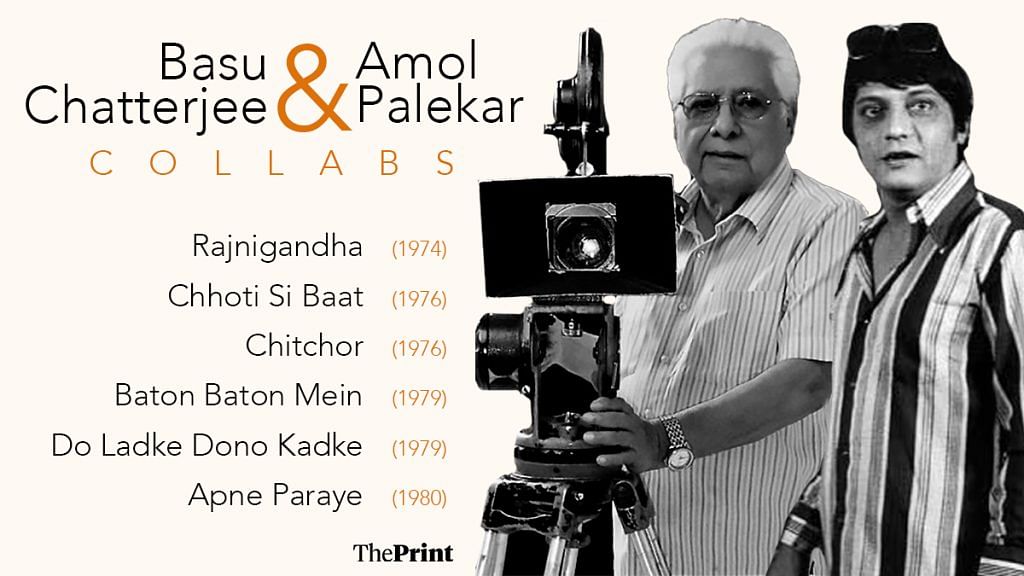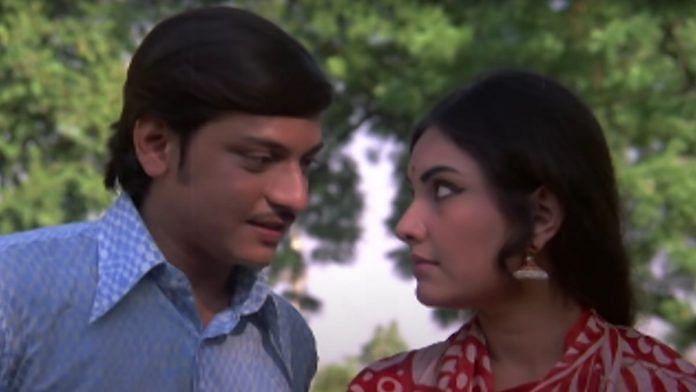Deepa is a woman torn between her past and present. As she rides through the streets of Bombay in the back of a kaali-peeli taxi with her former boyfriend, she cannot help but wonder if she should reach for his hand. But the thought of her partner and almost-fiancé back home in Delhi never leaves her. This tension—underscored by playback singer Mukesh’s Kai Baar Yun Bhi Dekha Hai in the background—is the crux of the 1974 film Rajnigandha.
Basu Chatterjee’s movie, starring Vidya Sinha, Amol Palekar and Dinesh Thakur, has aged well. It is as fresh, relevant, and contemporary as it was 50 years ago.
Deepa (Sinha), an independent and educated woman, reconnects with her old flame Navin (Thakur), five years after their ugly break-up. Now, she finds herself uncertain over whether she ever stopped loving him and if she truly loves Sanjay (Palekar), the man she plans to marry. It’s a theme, or rather a privilege, almost always reserved for male protagonists in Hindi films.
In an era where a woman’s inner turmoil did not exactly qualify as a crowd-puller or even an interesting film plot, Basu Chatterjee dared to adapt Hindi storyteller Mannu Bhandari’s short story Yehi Sach Hai to write Rajnigandha. He foregrounded the female lead’s complex emotions – such as her honest personal sense of love, infatuation and reality. The film, shot on a modest budget of Rs 7 lakh, went on to mark a surprising silver jubilee run at the box office and win the Filmfare Critics Award for Best Film (1975).
The 1970s, despite several iconic Hindi film hits, were largely characterised by multi-starrers, melodramatic love stories, the ‘angry young man’ wave, separated siblings, and so on. Women characters were relegated to the sidelines, often reduced to mere accessories and stereotypes. But Rajnigandha stood apart. It had no star power, villains, elaborate song and action sequences, pivotal crises, or earth-shaking climax.
Love & romance in Rajnigandha
Deepa is a Delhi-based PhD candidate in her early 20s, who intends to marry Sanjay, who is not quite the perfect boyfriend. He is rather forgetful and unpunctual and is often distracted by the fear of losing out on a much-awaited promotion at work, which he apologies for with a bouquet of Rajnigandha (tuberose) flowers every time, and Deepa happily accepts.
When a prospective job opportunity in Bombay (now Mumbai) comes calling for Deepa, Sanjay supports her ambition, expressing willingness to move to the new city with her to build a better life.
As Deepa arrives in Bombay for her big interview, she is greeted by Navin, her ex-boyfriend and a student union leader-turned-ad filmmaker, which takes her back in time. His attention and assistance in boosting her prospects for the job leave her confused about her feelings and wondering if he wants to get back together.

Deepa, the daydreamer, finds herself hesitating to tell him about Sanjay and doesn’t mind being mistaken for his girlfriend at a party. To her disappointment, however, Navin never says what she wishes to hear at the moment.
But once back home, she takes one look at Sanjay carrying the Rajnigandha flowers, and she knows it’s him she wants to be with.
Chatterjee’s film does not dramatise Deepa’s feelings of guilt and confusion, or blow them out of proportion, and at no point does it cast her in a negative light. Bollywood films have infamously shaped the idea of what love and romance should look like for generations. Rajnigandha portrayed the complexities of these emotions at a time when the articulation of conflicting thoughts by a woman protagonist was rare.
Encounters with old lovers stirring up feelings of nostalgia and familiarity—not necessarily, conflict—for women characters have most recently been explored by films like Three of Us (2022) and, further away from home, Past Lives (2023).
Also read: Rekha’s Ghar asks an important question—How does a couple survive sexual assault?
A departure from the norm
Rajnigandha also brought Amol Palekar to Hindi Cinema, setting the stage for him to become Bollywood’s ‘middle class’ hero. The film itself is often touted as an honest portrayal of middle-class life in the ‘70s—something that Chatterjee has been credited with for his other films, too.
Deepa and Sanjay are both aspirational middle-class people, seeking growth and better opportunities. Sanjay’s struggle with obtaining a promotion and Deepa’s excitement for a new job still strike a chord, and the desire to move to Mumbai or Bombay in search of a better life is not uncommon even today.
Basu Chatterjee’s film also allows a glimpse into life in the beaming metropolis—young, modern men and women with hectic jobs, frequent get-togethers over coffee or drinks with networking opportunities, and long taxi rides.
Rajnigandha did not boast of a star-studded line-up. Palekar—who had debuted in Marathi cinema before—and Vidya Sinha, were both new faces, and the distributors were not ready to bet on them. The film’s “rookie” producer, Suresh Jindal, had to struggle for two years after the film was shot. Eventually, Rajshri Productions stepped in, and Rajnigandha turned out to be a sleeper hit, featuring among the top-grossing Hindi films of 1974. Salil Chowdhury’s music, of course, helped its case. The movie had just two songs – a departure from the norm – but both became popular.
Rajnigandha was also remade in Bengali by Chatterjee in 2012, as Hothat Sedin.
(Edited by Zoya Bhatti)






